The Origins, Reasons, and Practice of the Inverted Christmas Tree; From Saturnalia and human sacrifice to Socks the cat
About 6-7 years ago I noticed a house that I drove by on my morning commute had an upside-down Christmas tree hung on the ceiling of its front porch. I chalked it up as simply being a one-off – a unique or incredibly uncommon occurrence. Having not grown up within a Christian household I figured it was something that some eccentric Christian practiced and I would just ask a religious friend what it was about.
None of my friends seemed to know, which I took as confirmation or validation of my one-off hypothesis. However, I saw another one pop up…and then another one. Then, lo and behold, I saw them for sale at a big-box store.
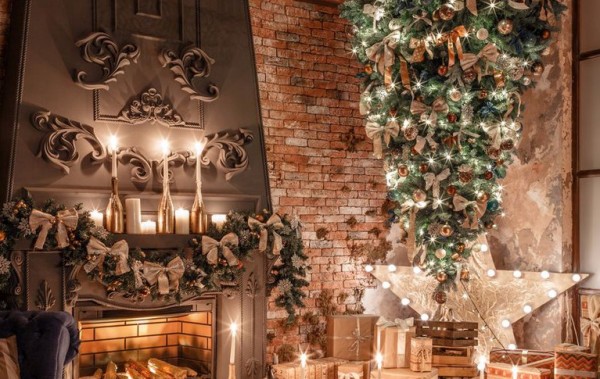
Being an absolute nerd when it comes to history, culture, and religions, I decided to find out the story behind the upside-down tree. Was it a passing fad or trend, or there was actually a history behind the practice – a sort of revival of an old tradition? Was it a rejection or statement about Christians or Christianity as an orthodox religion? Was it a pagan or “heretical” practice? Sacrilegious?
Here is what I found.
Like many historic stories, there is a lot of myth, confusion, or disagreement when it comes to origins. In fact, “playing” the Telephone Game or Chinese Whispers, will bear out how much an original story or message can change within a span of 30 seconds. So imagine trying to uncover the original story when it possibly, potentially, maybe goes back 1200 years or longer.
While it may not be possible to definitively point to the exact origin with any empirical certainty, we can have a little fun uncovering some of the tales. I don’t think one has to be a history nerd to be able to enjoy a travel through history – I’m a firm believer that the common stereotype of subjects deemed to be dull is not because of the subject itself but rather one of delivery.
Ever have a teacher in school that used the voice from the “dry eyes” commercial? Likely you didn’t enjoy the class and maybe even did poorly in it. I’m willing to bet that the classes you did well in or enjoyed, had roots in a teacher that at least did not use the “dry eyes” voice and likely was actually fun, funny, and witty. Inspiration and motivation is what it’s about, baby.
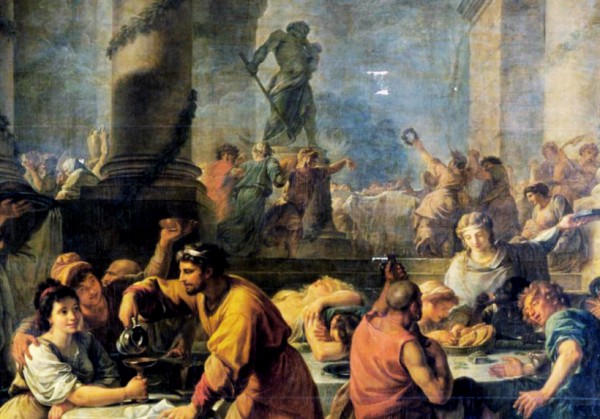
The Christmas tree has its origins in the celebration of Saturnalia
If we go back to the furthest historic mentions of the Christmas tree itself, was it right-side up or upside down? Well, the earliest mentions we have of a tree associated with a spiritual or religious celebration is the fir tree brought indoors in the ancient Roman festival of Saturnalia during the third week of December. Yes, it was a week-long celebration.
This precursor to the Christmas we celebrate today with presents, feasting, and er, sacrifice goes back to at least 5 B.C.E. Today, we sacrifice a ham or turkey, maybe a duck, but in going back to 5 B.C.E. or even earlier weapons of defeated enemies would be harvested and burned. Even humans were sacrificed but in an indirect way. Oh my Saturn, don’t get upset – they were already dead: munera was the ancient Roman term describing the burning or cremations of those gladiators who fought during Saturnalia celebrations and died.
Later, sometime around the 8th century A.C.E. the Germanic Pagans utilized a sacred tree called Jove’s Oak, or alternatively Thor’s Oak or Donar’s Oak. Who are these blokes? Well, by Jove they are the same bloke. Jove, Jupiter, Thor, or Donar are names given to the same god, planet or constellation of ideas. The oak or fir tree is associated by these gods as a symbol. The pagan concept of death – chopping down a live tree – and rebirth through breathing life into it in your home, sound familiar?
The tree is an allegory that was adopted by Christians who wanted to make it easier for pagans, heathens and savages to digest the gospel. Conquering Christians found out that it was futile to use the method of slaughtering their way into conversion – as their fellow Muslims did – since the threat of death wasn’t as effective as the death of an idea. So, finding a similarity in the pagan beliefs and tying that into the Christian ethos was found to be the far more effective method – one that would eventually be replaced entirely – or so they hoped – as future generations arrived.
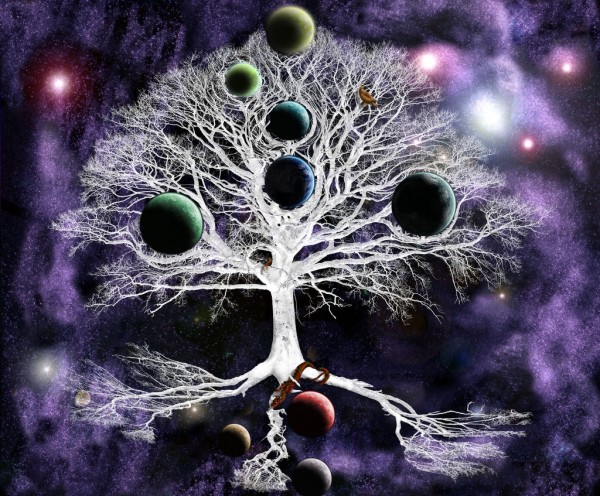
The sacred Yggdrasil Tree of the Old Norse Eddas
Legend has it that in the 8th century A.C.E. while the pagans were round the Donar’s Tree celebrating, they were still practicing some of the old ways in spite of giving the new Christian religion a genuine go. While some local-yokes were preparing to sacrifice some unlucky (or perhaps lucky since some felt it was grace or fortune to be chosen) young man under the tree St. Boniface, a missionary, interrupted and chopped that tree down.
Seizing the moment as a teaching opportunity the saint explained the tree as a holy symbol: by hanging it upside-down the shape of the tree from point to an increasingly wider apex resembled the cross upon which Jesus was crucified so he requested that they do so. Furthermore, he showed how the three points of the inverted triangle were reflections of the Holy Trinity: the Father, the Son (Jesus Christ), and the Holy Spirit.
I’m sure the young man was happy for St. Boniface’s interlocution. I bet that year’s celebration was one filled with gratitude, appreciation, and perspective.
Europeans, especially Central and Eastern ones, were said to have adopted the tradition of the inverted tree well into the 12th-century A.C.E. in spite of the lack of historical record bearing that out. In that part of the world an oak or fir tree would suffice, but often simply the tip of one or even a branch would be tacked to the rafters above the dinner table. Perhaps there is a relationship with tacking mistletoe. Regardless, some historians say the branch or tip has been conflated with being an entire tree. One of the earliest mentions of fake news.
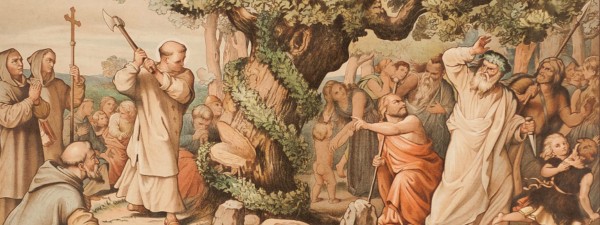
There is mention in the 16th-century A.C.E. Latvia, where the inverted tree was a popular representation of the biblical Garden Of Eden and it would be decked with herbs, flowers, and religious offerings of food – symbols themselves of abundance. Many early cultures believed the “As above, so below.” maxim and abundance in the “heavens” would reflect into abundance here on earth, and hopefully, that was demonstrated in the coming harvest season.
However, like the 12th-century A.C.E. stories, these are anecdotes without historical documents to back them up. That’s not to say they aren’t true, just that there is no way to prove the practice them as being true. Another case of early fake news?
Whether true or fake news, we do know for sure that the inverted tree was common among Slavic culture in the 1900s where it spread throughout Europe. Among the Poles, it was called podłaz or podłazniczek which doesn’t exactly roll of the tongue. I can say galumpki and pierogie with confidence, but not going near that one. Supposedly it is pronounced “pawd-wahz-NEE-chek” but that could be fake news too.
These Slavs took the abundance idea to the next level by decorating the tree with the first ornaments: ribbons, straw, paper-wrapped sweets, painted pine cones, fruit, nuts, and gingerbread. They would then offer the “abundance” to their kids or the carolers – for what is the point of abundance if you keep it to yourself? Joy is meant to be shared.
Interestingly, in 1570 a Germanic guild promoted the practice of allowing the children of their members to do what all kids, or…um, cats, wanted to do: give the tree a rustling and shaking to free to various treats so they would fall where they could be picked up and enjoyed. Forget that, cats aren’t interested in enjoying the treats just destroying the tree or batting about an ornament – the tree is just the casualty.

So if the inverted tree was so popular why did it never catch on in and persist into modern times? Why did we all grow up with a right-side-up tree when that allows the cat to destroy it, the frustration of trying to get the lights, tinsel, and ornaments all ’round the tree, the risk of it falling over, trying to orderly stack the gifts around the base having to finagle our way to the back end, toddlers having the opportunity to devour whatever is in reach, et al? Seems like a no-brainer to have it inverted. Are we gluttons for punishment?
Likely, just like religion, we often have a default position based in what we were taught growing up. Heck, why rock the boat, figuratively and soteriologically? While that is certainly one aspect, there is one of capability and practicality: modern homes are built differently than those going back even a few decades. Ever try to hang something in sheetrock or gypsum board? Not exactly the prime medium for something heavy like a Christmas tree.
However, for the above reasons, it makes a heck of a lot of sense. It’s far safer, more practical, has no risk of falling over or being knocked over by the cat, toddlers can’t reach it, there is more space to work with, and it’s far more convenient to decorate or ambulate around. Might be worth considering.
In fact, for those reasons, it has undergone a revival. Big-box stores are hanging trees upside-down to prevent kiddies from knocking it over or playing with the ornaments and perhaps choking on something. It allows their personnel to utilize more floor space as well. We plebs are utilizing for all the above reasons.
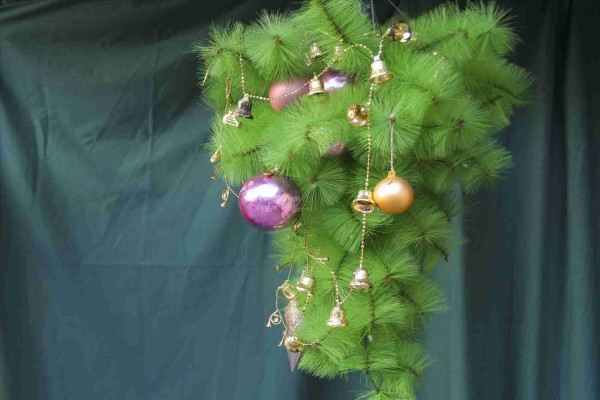
Since stores are now selling inverted trees with kits to hang them for those of use who are considering the idea, you can certainly try it out. However, considering that the price for these trees and their kits can go as high as $1400 it is probably more prudent to turn it into a -do-it-yourself project.
That idea about hanging a small portion of the top of a tree or just a branch is making more and more sense. Either way, like myself, many of you will find all the benefits of adopting an inverted tree for Christmas to be attractive ones. After a lifetime of right-side-up trees, what harm can come from giving it a go this year? At worst, it will be a failfest which can you abandon permanently, and at best it will breathe new life and meaning into a tradition that has become a bit stale and stagnant.
Besides, think of how many conversations it will invite during festivities? Breaking ice? A breeze. Trying to get the party started and getting a vibrant atmosphere going by having everyone talking? Done deal.
Even if you have to go through a little aggravation of learning to hang the tree in a small DIY project, then of how much less aggravation you’ll have when it comes to not dealing with it being knocked over, attacked by the cat, worrying about kids gobbling tinsel, and the extra space.
Best of all, it’s far, far less aggravation than finding a human sacrifice.